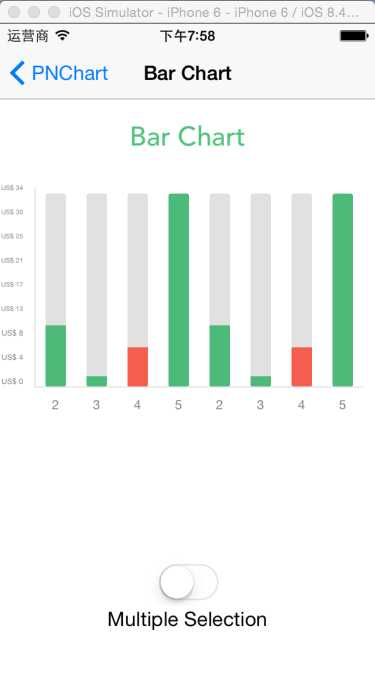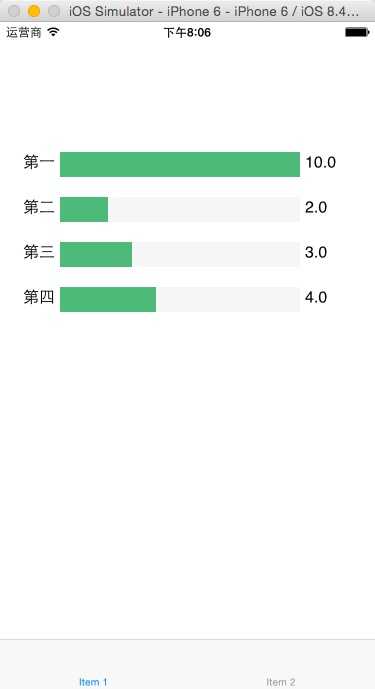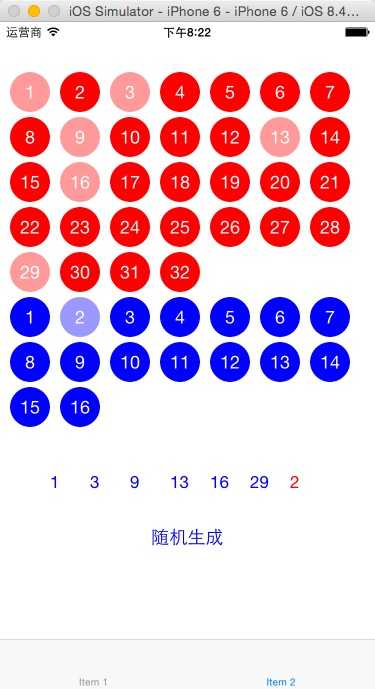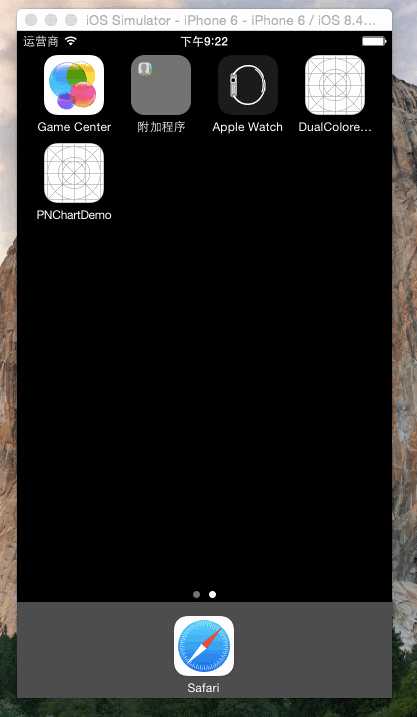标签:
叨逼叨
好久没更新博客了,才几个月,发生了好多事情,处理了好多事情。不变的是写代码依然在继续。
做点啥子
看看objective-c的书,学着写了个柱状图,只是练习的demo而已,iOS上的图表控件已经有非常好的解决方案了。
PNChart:https://github.com/kevinzhow/PNChart
这个控件是是挺不错了,喜欢的朋友可以看看,本文很多地方借鉴了PNChart,就当学习源码也可以

动手动手
先上图先上图,配色直接用PNChart的了,还蛮喜欢这种配色风格,一直不太喜欢把手机横过来,所以做了个竖版的,还有很多不完善,学的时间也短,大家别见笑哈~
ps:附带赠送双色球号码一注,大家可以去买,万一中了呢,由于女朋友老爹热爱福利事业,就写一个给他老人家玩玩,具体实现有人需要在贴吧,哈哈,我就是这么骗回复的


相关知识点
毕竟是新手入门的东西,列一下相关的知识点,如果后面有时间再一个个展开吧
OC语法方面:
NSArray,NSString,@interface,@property,@nonatomic,@implementation,id,alloc等
iOS方面:
UIView,CAShapeLayer,UIBezierPath,CATextLayer,UIColor,CABasicAnimation
撸代码
言归正传,看看代码实现部分
首先需要定义LZBar.h,包含了基本的声明,当然还缺少了X轴的文字说明,大家可以自己扩展下:
1 #import <UIKit/UIKit.h> 2 #import <QuartzCore/QuartzCore.h> 3 4 @interface LZBar : UIView{ 5 CAShapeLayer *backgroundLayer; //背景层 6 UIBezierPath *backgroundPath; //背景赛贝尔路径 7 CAShapeLayer *barLayer; //柱状层 8 UIBezierPath *barPath; //柱状赛贝尔路径 9 CATextLayer *textLayer; //数值文字显示层 10 CATextLayer *tittleLayer; //标题文字说明层 11 } 12 13 @property (nonatomic) UIColor *backgroundColor;//背景色 14 @property (nonatomic) UIColor *barColor;//柱的颜色 15 @property (nonatomic) float barProgress;//柱子长度 0-1之间 16 @property (nonatomic) float barWidth;//柱子宽度 17 @property (nonatomic) NSString *barText;//数值 18 @property (nonatomic) NSString *barTittle;//标题 19 20 @end
1 #import "LZBar.h" 2 3 @implementation LZBar 4 5 //初始化 6 - (id)initWithFrame:(CGRect)frame 7 { 8 self = [super initWithFrame:frame]; 9 if (self) 10 { 11 backgroundLayer = [CAShapeLayer new]; 12 [self.layer addSublayer:backgroundLayer]; 13 backgroundLayer.strokeColor = LZGrey.CGColor; 14 backgroundLayer.frame = self.bounds; 15 16 barLayer = [CAShapeLayer new]; 17 [self.layer addSublayer:barLayer]; 18 barLayer.strokeColor = LZGreen.CGColor; 19 barLayer.lineCap = kCALineCapButt; 20 barLayer.frame = self.bounds; 21 22 self.barWidth = self.bounds.size.width; 23 } 24 return self; 25 } 26 27 //设置背景 28 - (void)setBackground 29 { 30 backgroundPath = [UIBezierPath bezierPath]; 31 [backgroundPath moveToPoint:CGPointMake(self.bounds.origin.x, self.bounds.origin.y+self.bounds.origin.y+self.bounds.size.height/2)]; 32 [backgroundPath addLineToPoint:CGPointMake(self.bounds.size.width, self.bounds.origin.y+self.bounds.origin.y+self.bounds.size.height/2)]; 33 [backgroundPath setLineWidth:_barWidth]; 34 [backgroundPath setLineCapStyle:kCGLineCapSquare]; 35 backgroundLayer.path = backgroundPath.CGPath; 36 } 37 38 //设置百分百(显示动画) 39 - (void)setProgress 40 { 41 barPath = [UIBezierPath bezierPath]; 42 [barPath moveToPoint:CGPointMake(self.bounds.origin.x, self.bounds.origin.y+self.bounds.origin.y+self.bounds.size.height/2)]; 43 [barPath addLineToPoint:CGPointMake(self.bounds.size.width*_barProgress, self.bounds.origin.y+self.bounds.origin.y+self.bounds.size.height/2)]; 44 [barPath setLineWidth:_barWidth]; 45 [barPath setLineCapStyle:kCGLineCapSquare]; 46 47 CABasicAnimation *pathAnimation = [CABasicAnimation animationWithKeyPath:@"strokeEnd"]; 48 pathAnimation.duration = 1.0; 49 pathAnimation.timingFunction = [CAMediaTimingFunction functionWithName:kCAMediaTimingFunctionEaseInEaseOut]; 50 pathAnimation.fromValue = @0.0f; 51 pathAnimation.toValue = @1.0f; 52 [barLayer addAnimation:pathAnimation forKey:nil]; 53 54 barLayer.strokeEnd = 1.0; 55 56 barLayer.path = barPath.CGPath; 57 } 58 59 //设置柱子的宽度 60 - (void)setBarWidth:(float)progressWidth 61 { 62 _barWidth = progressWidth; 63 backgroundLayer.lineWidth = _barWidth; 64 barLayer.lineWidth = _barWidth; 65 66 [self setBackground]; 67 [self setProgress]; 68 } 69 70 //设置背景色 71 - (void)setBackgroundColor:(UIColor *)backgroundColor 72 { 73 backgroundLayer.strokeColor = backgroundColor.CGColor; 74 } 75 76 //设置柱子颜色 77 - (void)setBarColor:(UIColor *)barColor 78 { 79 barLayer.strokeColor = barColor.CGColor; 80 } 81 82 //设置柱子进度 83 - (void)setBarProgress:(float)progress 84 { 85 _barProgress = progress; 86 [self setProgress]; 87 } 88 89 //设置数值 90 - (void)setBarText:(NSString*)text{ 91 textLayer = [CATextLayer layer]; 92 textLayer.string = text; 93 textLayer.foregroundColor = [[UIColor blackColor] CGColor]; 94 textLayer.fontSize = 16; 95 textLayer.alignmentMode = kCAAlignmentLeft; 96 97 textLayer.bounds = barLayer.bounds; 98 textLayer.position = CGPointMake(self.bounds.size.width*3/2 + 5 , self.bounds.size.height/2); 99 CABasicAnimation *fade = [self fadeAnimation]; 100 [textLayer addAnimation:fade forKey:nil]; 101 [self.layer addSublayer:textLayer]; 102 } 103 104 //设置标题 105 - (void)setBarTittle:(NSString*)tittle{ 106 tittleLayer = [CATextLayer layer]; 107 tittleLayer.string = tittle; 108 tittleLayer.foregroundColor = [[UIColor blackColor] CGColor]; 109 tittleLayer.fontSize = 16; 110 tittleLayer.alignmentMode = kCAAlignmentRight; 111 112 tittleLayer.bounds = barLayer.bounds; 113 tittleLayer.position = CGPointMake(-self.bounds.size.width/2 - 5 , self.bounds.size.height/2); 114 CABasicAnimation *fade = [self fadeAnimation]; 115 [tittleLayer addAnimation:fade forKey:nil]; 116 [self.layer addSublayer:tittleLayer]; 117 } 118 119 //渐变动画 120 -(CABasicAnimation*)fadeAnimation 121 { 122 CABasicAnimation* fadeAnimation = [CABasicAnimation animationWithKeyPath:@"opacity"]; 123 fadeAnimation.fromValue = [NSNumber numberWithFloat:0.0]; 124 fadeAnimation.toValue = [NSNumber numberWithFloat:1.0]; 125 fadeAnimation.duration = 2.0; 126 127 return fadeAnimation; 128 } 129 @end
有了Bar之后问题就变的简单的多了,我们可以在构建一个Chart,方便我们直接使用,防止内容过长,看起来累,代码我就折叠了~

1 #import <UIKit/UIKit.h> 2 3 @interface LZChart : UIView{ 4 CGSize size;//图表大小 5 } 6 7 @property (nonatomic)NSArray *numLabels;//值 8 @property (nonatomic)NSArray *nameLabels;//名称 9 @property (nonatomic)float maxNum;//最大值 10 11 @property (nonatomic)NSInteger barSpacing;//两根柱状图的间距 12 13 @property (nonatomic) CGFloat chartMarginLeft; 14 @property (nonatomic) CGFloat chartMarginRight; 15 @property (nonatomic) CGFloat chartMarginTop; 16 @property (nonatomic) CGFloat chartMarginBottom; 17 18 - (void)show;//现实图标 19 20 @end

1 #import "LZChart.h" 2 #import "LZBar.h" 3 4 @implementation LZChart 5 6 -(id)initWithFrame:(CGRect)frame{ 7 self = [super initWithFrame:frame]; 8 if (self) { 9 size = frame.size; 10 _chartMarginTop = 30.0; 11 _chartMarginBottom = 30.0; 12 _chartMarginLeft = 30.0; 13 _chartMarginRight = 30.0; 14 _barSpacing = 20; 15 } 16 return self; 17 } 18 19 -(void)show{ 20 [self setMaxNum]; 21 22 float barCount = [_numLabels count]; 23 float barMaxWidth = size.width - _chartMarginLeft - _chartMarginRight ; 24 float barHeight = (size.height - _chartMarginTop - _chartMarginBottom) / barCount - _barSpacing; 25 //防止柱状图太粗 26 if(barHeight > 25){ 27 barHeight = 25; 28 } 29 float barWidth = 0; 30 31 for(int i = 0;i<barCount;i++){ 32 LZBar *bar = [[LZBar alloc] initWithFrame:CGRectMake(_chartMarginLeft, _chartMarginTop + i*(barHeight + _barSpacing), barMaxWidth, barHeight)]; 33 barWidth = [_numLabels[i] floatValue]; 34 bar.barProgress = barWidth/_maxNum; 35 bar.barWidth = barHeight; 36 bar.barText = [NSString stringWithFormat:@"%.1f",barWidth]; 37 bar.barTittle = [NSString stringWithFormat:@"%@",_nameLabels[i]]; 38 [self addSubview:bar]; 39 } 40 } 41 42 -(void)setMaxNum{ 43 _maxNum = 0; 44 for (id num in _numLabels) { 45 if ([num floatValue] > _maxNum) { 46 _maxNum = [num floatValue] ; 47 } 48 } 49 } 50 @end
然后在需要添加的UIView直接调用,是不是很容易呢
1 LZChart *chart = [[LZChart alloc] initWithFrame:CGRectMake(30, 100, 300, 300)]; 2 chart.numLabels = [NSArray arrayWithObjects:@10,@2,@3,@4, nil]; 3 chart.nameLabels = [NSArray arrayWithObjects:@"第一",@"第二",@"第三",@"第四", nil]; 4 [self.view addSubview:chart]; 5 [chart show];
最终效果:

希望大家喜欢~
博客地址: http://www.cnblogs.com/nightcat/
博客版权: 本文以学习、研究和分享为主,欢迎转载,但必须在文章页面明显位置给出原文连接。
如文中有不妥或者错误的地方还望高手的指出,以免误人子弟。如果觉得本文对您有所帮助请【推荐】一下!如果你有更好的建议,不妨留言一起讨论,共同进步! 再次感谢您耐心的读完本篇文章。
标签:
原文地址:http://www.cnblogs.com/nightcat/p/ios_01.html